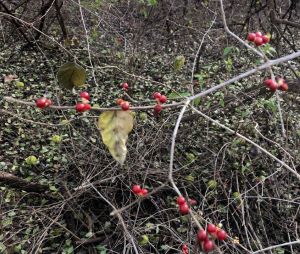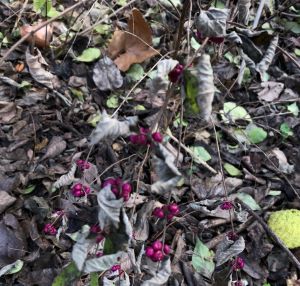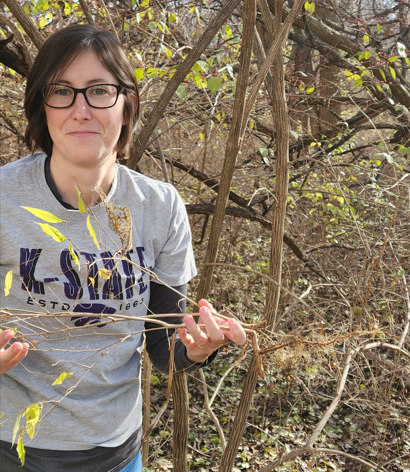Bush Honeysuckle and Coralberry along the Sunset Nature Trail
The beginning of winter and early spring are excellent times to go out and actually start working on your invasive bush honeysuckle removal project. Honeysuckle retains its green leaves well after other plants have gone dormant, making it easy to identify. In the spring, it is one of the first forest plants to develop leaves.
Here at the nature trail behind the Johnson County Sunset Drive Office Building, we have lots of bush honeysuckle to contend with. This domination of the forest floor is very common in the forests of Northeastern Kansas. Why is honeysuckle considered invasive? In ecology, a species is labeled “invasive” if it is both non-native to an ecosystem it is inhabiting AND is causing measurable harm to the native species present in that ecosystem. Common characteristics of invasive species include their ability to rapidly spread/reproduce and their generalist nature. Generalist species, like raccoons, are adapted to thrive in many different habitat types. They are hardy, utilize many food sources, and can withstand change much better than specialist species like the black-footed ferret that relies solely on prairie dogs for food.

Back to bush honeysuckle, honeysuckle was originally brought here from Japan as an ornamental shrub. It didn’t take long for it to escape the confines of landscaped yards and start spreading across the country. Honeysuckle is detrimental to forest health because through its ability to spread quickly, it is capable of completely blanketing the forest understory, almost completely eliminating any sapling growth by native hard wood trees such as oaks and hickories. It forms such a thick layer of plant matter from 1 to 10 feet from the ground that wildlife begin to avoid it. Bush honeysuckle is spread mainly by birds who eat the bright red berries and disperse the seeds elsewhere, thus assisting bush honeysuckle with its run at world dominance.
So, how do you remove it? Will fire do the trick? Unfortunately for most infestations, the plants are too mature and established to be affected by fire. Honeysuckle is very good at resprouting from the roots. While the fire will burn away the portion of the plant that’s above ground, the roots of the shrub will survive and resprout. Fire will kill very young bush honeysuckle and can be used to keep honeysuckle from coming back after it has been eradicated. How about using goats to get rid of it? While yes, goats will eat a lot of the honeysuckle growing a foot to 6 feet off the ground, they can’t reach much of the taller honeysuckle.
The larger honeysuckle will quickly regenerate what was eaten and possibly become even more thick as a response. Like fire, goats have the ability to kill young honeysuckle and can be used to keep forest areas honeysuckle free.
What’s the solution? It depends on the size of the plant. For young plants, pulling the entire plant out of the ground, roots and all, is the best solution.
For more mature plants, it’s best to cut the shrub down by its base and apply Tordon to the exposed trunk top. This will kill the plant entirely, including its roots. After all the plants have been removed, monitor the area for new sprouts. It would be a shame to work so hard to remove it, just to have it re-establish itself.
While removing bush honeysuckle, be sure to keep an eye out for a native shrub that’s range includes northeastern Kansas: coralberry. Coralberry is a deciduous shrub that only grows to around 4 feet tall. It gets its name by the purple/pink berries it produces (compared to honeysuckle’s bright red berries). While a tad aggressive in spreading, coralberry allows enough sunlight to pass through to the forest floor, thus allowing tree saplings to grow.
In a healthy forest, you should be able to see trees in all stages of life. With coralberry, that is possible. With honeysuckle, it’s not. So, when you’re out there removing bush honeysuckle, be sure not to remove coralberry by mistake!

